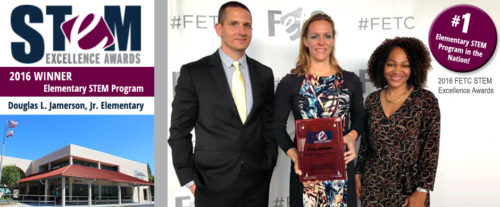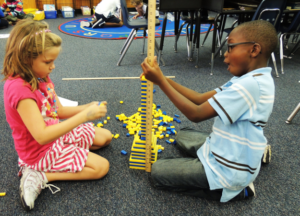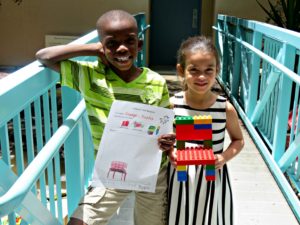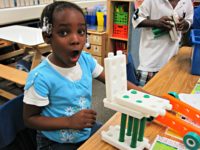
This has been a busy school year for the students, teachers and leaders of Douglas L. Jamerson Junior Elementary School (DLJ) in Pinellas County. The magnet school has earned a number of awards, including MSA’s School of Excellence Award, they were named the top Elementary STEM program in the nation by the Future of Education Technology Conference, they are a National PTA School of Excellence, and they have also been named a Five Star School by the Florida Department of Education. Not only has the school really shined this year, but one of the architects behind their incredible curricula was recognized. Lukas Hefty, DLJ’s very own Magnet Coordinator, was honored with the Milken National Educator Award. This prestigious award lauds educators who have made significant contributions to the profession. The awards program is known to many as the “ Oscars of Teaching.” Hefty’s stand-out work is worth studying. He’s incredibly humble and attributes his success in education to his early years at Jamerson, where the staff came together to develop the highly sought-after curriculum they use today.
Hefty’s Early Years
Douglas L. Jamerson Junior Elementary opened its doors in 2003 and was funded by the Magnet Schools Assistance Program (MSAP) grant. Hefty transferred to Jamerson in August of 2005. In his first few years, Hefty taught 2nd and then 5th grade. Eventually he began spending half his time teaching and the other half working on curriculum, his split schedule helped him ease into the role of Magnet Coordinator which he occupies today. When he first signed on to work at DLJ, he joined a cohort who agreed to get nationally board certified (the school still holds the same standard for their teachers, more than half have Masters degrees as well). Not only did this shared goal help cement the strong professional relationships between teachers, but the school also employed individuals with varying levels of experience in the field – the layering of skill levels and expertise created a mentoring dynamic among the faculty and staff.
 In these first critical years after the school was founded, the staff embarked on an important mission – build a comprehensive engineering curriculum for elementary school students. Lukas Hefty recounts, “The curriculum development process was a 4-year collaborative journey.” During the following years, the curriculum evolved with changing technologies, changing science standards, and the needs of the students, but the basic structure of the curriculum includes 6-7 units of study each year, each unit is 5-6 weeks long, and each unit culminates in an engineering design challenge. The design challenge brings all the skills the students learn throughout the year together.
In these first critical years after the school was founded, the staff embarked on an important mission – build a comprehensive engineering curriculum for elementary school students. Lukas Hefty recounts, “The curriculum development process was a 4-year collaborative journey.” During the following years, the curriculum evolved with changing technologies, changing science standards, and the needs of the students, but the basic structure of the curriculum includes 6-7 units of study each year, each unit is 5-6 weeks long, and each unit culminates in an engineering design challenge. The design challenge brings all the skills the students learn throughout the year together.
How Does DLJ Teach Engineering to ALL Students?
Hefty admits that as an educator it’s often challenging to meet the needs of all students at once, especially in classes with diverse skill levels, but teachers at DLJ have found ways to not only make engineering relevant to their young students, but also address students at the varying comprehension levels represented in their classrooms. For students who are struggling, the school offers a science club which makes getting extra help a fun and special treat, as opposed to a punishment. Many classrooms also have hourly teachers that are there to support small groups and pull struggling students throughout the day for extra assistance. Hefty stressed the importance of building a strong six year program where pre-k – 2nd grade teachers work hard to create a strong foundation upon which 3rd – 5th grade teachers can build.
Teachers foster a positive attitude toward failure and struggle. At Jamerson, learning experiences, including unsuccessful tries, are all part of a continuous design process and in Hefty’s words, “Failure is simply a chance to re-design.” This openness and comfort with failure teaches students not to fear trial and error but to acknowledge missteps as expected outcomes of hard work and experimentation. When students are unafraid of failure, the sky becomes the limit.
Design Challenges Cross Disciplines and Engage Students
 How does one make engineering relevant to a 5-year-old?
How does one make engineering relevant to a 5-year-old?
Jamerson’s answer: involve Goldilocks.
One example of a relevant, cross-curricular unit that captures the spirit of Jamerson is the Goldilocks: an Engineer lesson plan. Instead of reading Goldilocks the way young children normally would, kindergarteners are challenged to “read like engineers” and to detect the design challenge Goldilocks faces in the story. By assigning students the role of engineers – in other words, problem solvers – out to find a solution to Goldi’s problems, 5-year-olds start to learn critical thinking. The students in the first Goldilocks class defined the broken chair as Goldi’s problem and with that, a design challenge was born.
The kindergarteners were then tasked with building a “just-right” chair for Goldilocks. The process of planning, trying out materials, measuring, and re-testing is hands on. In the process of planning and executing this chair assignment, students are not just pushed to critically think but to physically build with the materials of their choice. They also have to collaborate with their classmates. The Goldilocks Lesson Plan and Jamerson’s way of educating young students about engineering principles is successful because the design challenges, though tricky, are approachable. Students are provided with necessary tools and support plus the story behind each challenge makes the task relevant to their interests and age level.
Mr. Hefty and Douglas L. Jamerson Junior Elementary have experienced great successes for a number of reasons: their patience and persistence (Hefty emphasized that the curriculum, the student success, the parental participation in their school, all took time to achieve), collaborative efforts as a faculty and staff, and positive approach to failure.
 View their Science Achievement Data Here
View their Science Achievement Data Here
Visit DLJ’s Website to Learn More